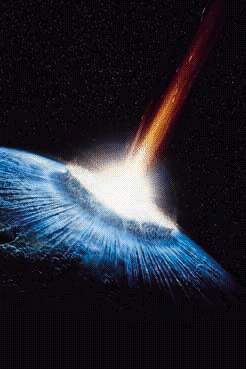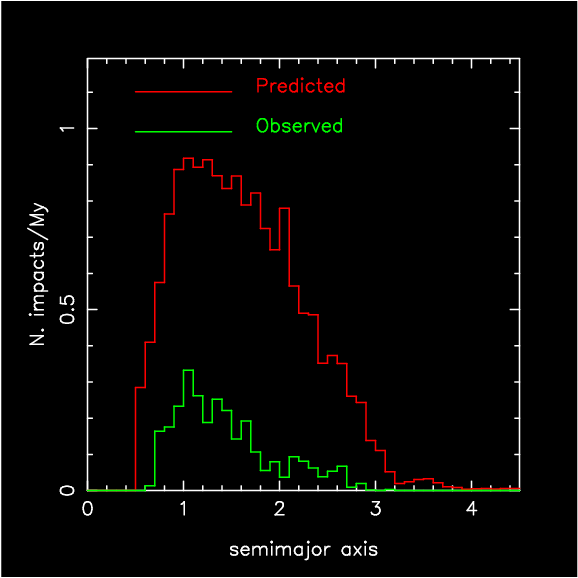IMPACT HAZARDS ON EARTH
 |
How often does the Earth suffer
a NEO impact powerful enough to produce
catastrophic consequences for the environment?
Impact energy determines the
degree of devestation produced by an asteroid striking the Earth. According
to the UK Task-Force
on NEO hazards, 1,000 megaton
TNT (MT) impacts can potentially produce regional physical damage,
but the implications of such an impact to our world-wide linked economic
system would almost certainly be global.
|
To estimate the NEO collision
frequencies as a function of impact energy we employ our NEO distribution
model. Recall that our model provides the distribution of the Near Earth
Objects in terms of semi major
axis, eccentricity, inclination,
physical size and albedo. The only
remaining component needed to compute impact energy is the projectile's
bulk
density of the objects; we use this value to estimate the projectile's
mass.
Fortunately, measurements of
the asteroid bulk densities, derived from spacecraft data and asteroid
satellite observations, show a sharp correlation between bulk density and
asteroid taxonomic class:
asteroids in the C taxonomic class have bulk densities of ~1.3 grams per
cubic centimetre, while asteroids in the S taxonomic class have bulk densities
of ~2.7 grams per cubic centimetre. Therefore, it is reasonable to assume
that the former density is applicable to bodies with albedo smaller than
9%, while the latter value is applicable to higher albedo bodies.
Accordingly, we estimate that
the typical interval between collisions with impact energy of 1,000 megatons
TNT is ~65,000 years. This interval increases to ~250,000 years for energies
of 10,000 megatons and ~1 million year for energies of 100,000 megatons.
| reference impact energy |
Average impact interval |
average D of impactors |
average Hof
impactors |
Observational completeness of the corresponding population |
| > 1,000 MT |
63,000 y |
277 m |
20.5 |
18% |
| > 10,000 MT |
241,000
y |
597 m |
18.9 |
37% |
| > 100,000 MT |
925,000
y |
1287 m |
17.3 |
49% |
Our predicted interval between impacts on Earth
is roughly a factor of 4 larger (or, equivalently, the impact rate is 4
times smaller) than in previous estimates. This difference can be attributed
to a more precise evaluation of the NEO population (current estimates are
roughly half of previous estimates), a better model of the NEO orbital
distribution, and updated information on the bulk densities of real asteroids.
 |
The expected number of collisions carrying an impact
energy larger than 1000 megaton TNT, as a function of the impactors'
semi major axis (red histogram).
For comparison, the green histogram shows the number
of collisions expected from the known NEO population. The completeness
of the known population, measured relative to its total collision
probability is only 18%. This result implies that there is an 82% chance
that we have not yet discovered the NEO that will make the next 1,000 MT
impact on Earth. |
The stated Spaceguard
goal of the current NEO surveys is to discover 90% of the NEOs with
H<18.
However, it would be appropriate:
1) to push the value of H to 20.5, which corresponds
- on average - to impact energy ~1,000 megaton
TNT;
2) to state the goal in terms of discovering the NEOs
carrying 90% of the total collision probability. The comparison between
the figure above and that
of the raw distribution of NEOs shows that the two goals are not equivalent.
For instance, the Atens (a<1
AU),
despite the fact that they are only 6% of the total NEO population, carry
about 20% of the total collision probability. Thus, the discovery
of Atens - of secondary importance for the original Spaceguard goal - becomes
a top priority when collisional hazards are taken into account.
NEXT PAGE
PREVIOUS PAGE
FIRST PAGE

